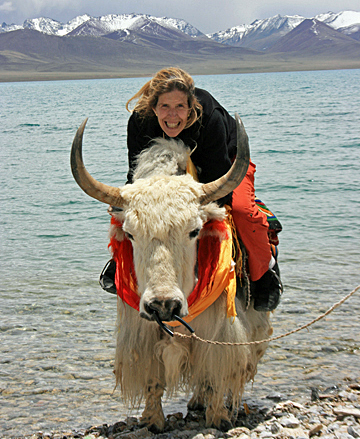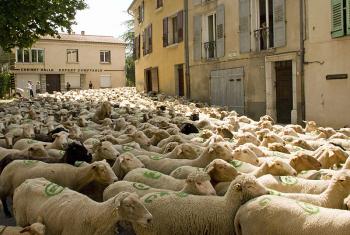For almost five months of the year I am tethered to my Samsonite roller bag, a modest collection of three-ounce unguents and gels, and a cell phone that is pre-programmed to tell me the current time in Tierra del Fuego, Chile, or the weather forecast for Salalah, Oman.
As the editor of Wild Fibers, a quarterly publication most commonly referred to as, "The National Geographic of fibers," my job involves traipsing about the world to find uncommon stories about wool. I am just as apt to be in a tent in the Gobi Desert with 1,000 cashmere goats sleeping 20-feet from my pillow, as I am to spend the afternoon with 30 women in northern Afghanistan who are raising silkworms in order to earn enough money to send their children to school.
If you ask me how a cashmere goat farmer from Union wound up with a million frequent flyer miles, or chasing after a herd of musk oxen around the Arctic (in December!) I don't really know. I do know, however, that by the second week of June I tuck away my passport into my top bureau drawer and vow to go nowhere for the next eight weeks.
For me, choosing to leave Maine during the summertime isn't just silly, it's insane, which aptly described my mental state as I was standing in line at Gate 11 at Boston's Logan International Airport on June 17.
Against my better judgment, or perhaps I should say in accordance with my professional needs, I was leaving home-sweet-home to travel to the French Alps on business, because if you are a sheep, and if you live in southern France, you do spend your summers in the alps. It's just too stinkin' hot with all that wool to stay at home!
What most people don't know, (particularly those who live in Maine or don't visit southern France with any regularity) is that shepherds still travel into the alps with a flock of several thousand sheep and stay there (alone) until the snow flies in early October. Even in today's world of uber technology, which seems to have an answer for problems we didn't even know we had, the traditional transhumance is still practiced not far from the chic shores of the Cote d'Azur, and where a simple goat farmer from Maine found herself somewhat reluctantly once again chasing after a band of woolies because during the months of March, April or May (when leaving Maine might be considered more desirable) the sheep are still happily resting at home — and that's not an uncommon story.
As is often the case with my job, the plans in place at the time I make my plane reservations are not the plans that have unfolded by the time I actually board my flight. Initially, I had thought I would also go chasing after some sheep in Switzerland (where an annual transhumance is still practiced in many areas) before heading to the flock in France. But this past winter, which not only delivered unusual patterns of extreme cold (lest we need reminding), but also a dose of Pineapple Express, the Swiss Alps had warmed up faster than the French Alps, and by the time I boarded my flight for Zurich the sheep had already left. And, to complicate matters further, the sheep in France weren't quite ready to go. (No one has made a phone app to address this problem.)
And so it was with more than a mild sigh of relief when I woke up on a Sunday morning in Riez, France, where there is a truffle market every Wednesday, most of the farmers grow lavender and you can "do lunch" on the Mediterranean in less than two hours. But more importantly, once a year you can see 1,500 sheep come trotting down Main Street on their way to the Alps, which is, afterall, the only reason I agreed to leave Maine in the first place.
Although it is right to assume that the majority of the sheep outside of Australia (and now China) are primarily meat animals, there is a native wool breed still raised in southern France called the Merinos d'Arles. The breed is derived from an ancient crossbreeding of the Spanish Merino with the local breed from the area around the town of Arles. Hence, the name, which means the "Merinos of Arles."
One of the first lessons taught in Wool 101 is that the merino breed produces exceptionally fine and crimpy wool, perfectly suited for soft knitting yarn or a finely woven suit. If both my hands weren't already occupied balancing my camera and zoom lens, I would have been tempted to snatch a handful from the back of a four-footed passerby. But I have seen sample fleeces and there is no question, these Sunday window shoppers deserve equal adulation as their couture counterparts.
It's not every day you see a flock of sheep parading down the street. Although in the United States, we still honor the transhumance tradition with the annual Trailing of the Sheep Festival in Sun Valley, Idaho, where a band of sheep also travels down Sun Valley’s Main Street on a Sunday morning once a year, to the delight of thousands of spectators, who have undoubtedly long since forgotten the sheepherding traditions of our Western forefathers.
The difference between the festival in Riez, and the one in Sun Valley is subtle. Well, maybe not that subtle. In Riez, the sheep are French and so they go "bàh" and not "baah..." In Riez, the sheep trot past cafés where stilettos and silk blouses are considered de rigueur, even on a Sunday at 10 a.m. In Sun Valley, most everyone has broken out their flannels and is clutching a triple-something take-out from Starbucks. (Eating and drinking on the go is just plain crass most everywhere but the U.S.)
Food and fashion aside, the French have a well deserved reputation for doing everything with a flair and rather than let this feisty flock be the sole source of entertainment, I just happened to look up and notice a pair of tightrope walkers (dressed as sheep!) maneuvering their way across a makeshift wire that had been erected over Main Street.
Voila, I'll show ewe!
As luck would have it, I was in the perfect position to capture a photo of the sheep coming into town, but I was stuck in the shadows when it came to photographing the "other" entertainment.
Disappointed that they had finished their performance by the time I shoved my way through the crowd to get a better shot, I was suddenly struck with the happy realization that even though I may not have captured the perfect picture, I wouldn't have gotten anything if I hadn't been willing to pack up my bags and head for the hills, even in summertime, when there's definitely no place like home.
 Linda Cortright is the editor and publisher of Wild Fibers magazine, which is published at JS McCarthy in Augusta. She moved to Maine in 1995 to start raising cashmere goats and has lived on Grumble Goat Farm in Union since 1997. Cortright maintains an office in downtown Rockland, although admittedly she is rarely there.
Linda Cortright is the editor and publisher of Wild Fibers magazine, which is published at JS McCarthy in Augusta. She moved to Maine in 1995 to start raising cashmere goats and has lived on Grumble Goat Farm in Union since 1997. Cortright maintains an office in downtown Rockland, although admittedly she is rarely there.


Shepherd-control.jpg)






























